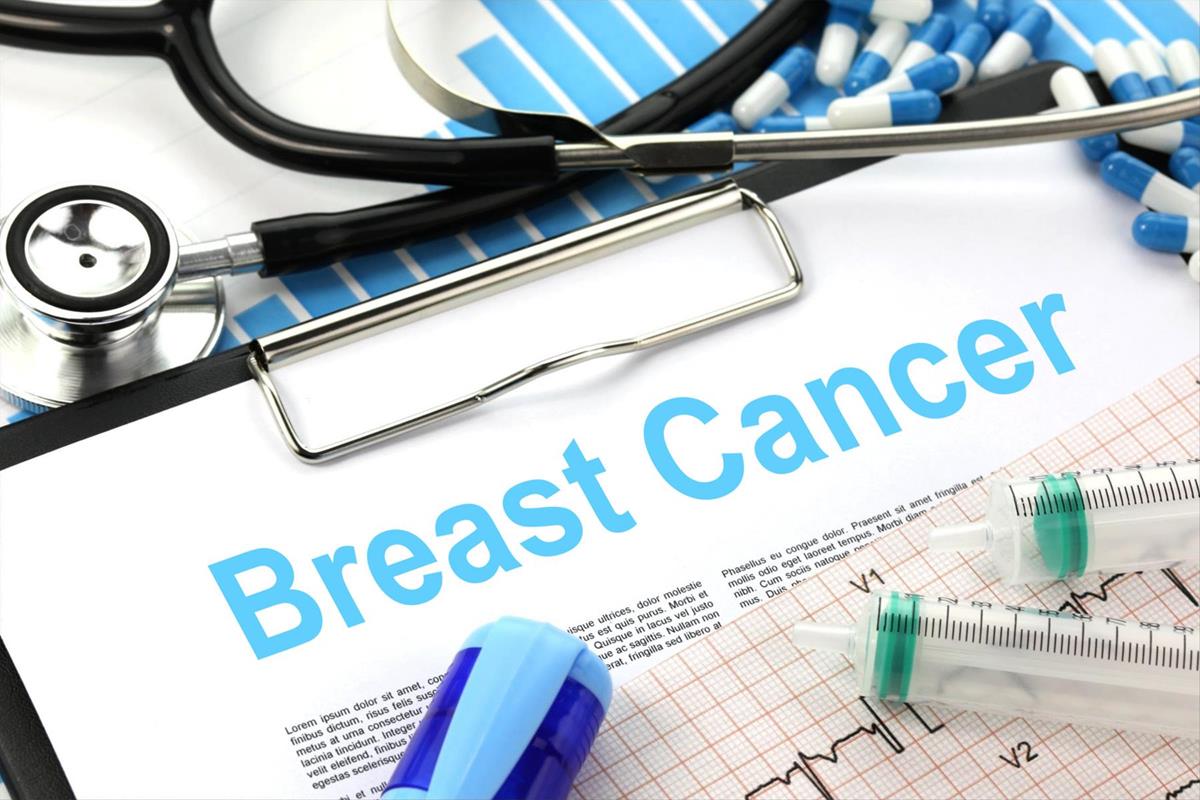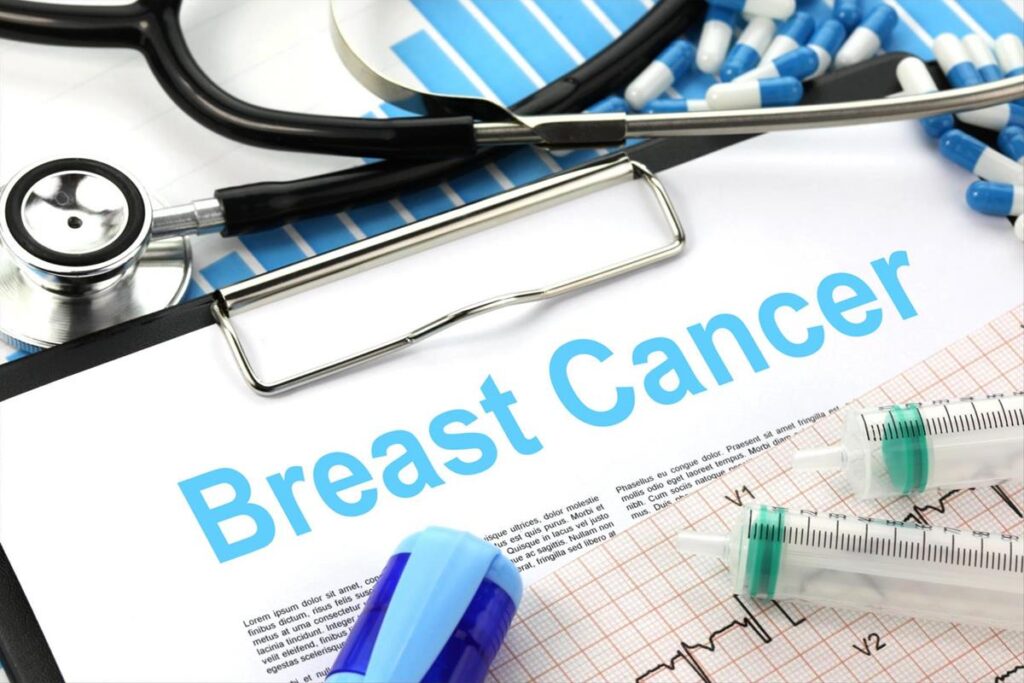
Several types of special pathology tests can be done on breast cancer tissue removed during surgery or biopsy. These tests can help determine whether the tumor is likely to grow slowly or quickly, whether it is likely to recur, and whether is it likely to respond to certain types of treatment. Some common tests are estrogen and progesterone hormone receptors, HER2, and cell proliferation.

Breast Surgery
Nearly all women with breast cancer will have some type of surgery. A lumpectomy is an operation to remove only the cancer and the surrounding normal tissue. The goal with a lumpectomy is to remove the cancer without leaving residual cancer cells in the breast. Lumpectomy usually is followed by radiation therapy to destroy any cancer cells that may remain in the breast. Lumpectomy is an option for many women with breast cancer. An operation to remove the breast is a mastectomy. In a simple mastectomy, the entire breast is removed. In a modified radical mastectomy, some axillary lymph nodes are removed along with the breast tissue.
Studies have shown that patients treated with lumpectomy plus radiation have comparable survival to women treated with mastectomy. The decision between a mastectomy and lumpectomy depends on many factors, including the patient’s preference, size of the tumor, likelihood that all of the tumor can be removed without removing the entire breast, size of the breast, anticipated cosmetic result, ability to adequately monitor the patient for recurrence after surgery, patient’s age and health, and how far a patient lives from a radiation therapy facility.
Lymph Node Surgery
Whether a woman has a mastectomy or lumpectomy, it is important to know whether the cancer involves the lymph nodes under the arm, an indicator of possible spread throughout the body. In most cases of invasive breast cancer, the surgeon also removes lymph nodes under the arm to help determine the stage of disease and plan further treatment. Although the lymph node status provides important information that helps in making recommendations about the need for radiation and chemotherapy, the long term side effects lymphedema, nerve injury, and limitations on range of motion can be uncomfortable and occasionally debilitating. Surgeons are currently investigating a way to reduce the number of axillary lymph node dissections performed in breast cancer patients by using a technique called sentinel lymph node mapping .
Reconstructive Surgery
Breast reconstruction can be done at the same time as the mastectomy or months to years later. Breast reconstruction typically involves either the insertion of a saline implant or a tissue transplant. Saline implants are not thought to impose any risk to the local tissue or to other parts of the body. Tissue transplants involve taking muscle, fat, and skin from the lower stomach, back, or buttock and moving it to the chest area, where it is shaped into the form of a breast. Many women report physical and emotional satisfaction from these types of breast reconstruction, but many women opt not to have this additional surgery.
Radiation Therapy
Radiation can destroy cancer cells left behind in the breast, chest wall, or armpit after surgery. Occasionally it can be used to shrink a tumor before surgery. In most cases, a lumpectomy is followed by radiation therapy, to reduce the risk of local recurrence of the breast cancer within the remaining breast. In some cases, radiation is also recommended following a mastectomy, if there is a high risk of tumor cells remaining behind after surgery. When radiation therapy follows breast surgery, a machine delivers radiation to the breast and chest wall and in some cases to the lymph nodes.
Possible side effects of radiation to the breast or chest wall include fatigue and skin irritation, such as itchiness, redness, soreness, peeling, or darkening of the breast. Changes to the breast tissue and skin usually go away in six to twelve months. In some women, the breast becomes smaller and firmer after radiation therapy. Radiation therapy of underarm lymph nodes can also cause lymphedema. Radiation to the breast does not cause hair loss, vomiting, or diarrhea, nor does it make the patient radioactive.
Chemotherapy and Hormonal Therapy
Therapies that circulate through the body’s bloodstream to attack cancer cells wherever they may have spread are called “systemic” treatments. The most commonly used breast cancer systemic therapies are chemotherapy and hormonal therapy.
Systemic treatment given to patients after surgery is called adjuvant therapy. This is aimed at reducing the likelihood of tumor spread and recurrence in the future and increasing the possibility of cure. Adjuvant therapy does not guarantee that distant spread of cancer will not occur in the future, but it does lower the likelihood.
The decision about whether to include adjuvant chemotherapy or hormone therapy in the breast cancer treatment plan weighs the possible benefits to be gained from the treatment with the risks and side effects of the treatment. Many factors are taken into consideration, including the patient’s overall health, the stage of the tumor, and the hormone receptor status of the tumor. The pathologic grade of the tumor, DNA studies, and HER2 studies may also influence the decision about whether a patient may benefit from systemic therapy.
Therapy given before breast surgery is called “neoadjuvant” therapy. This approach is commonly used in larger, more advanced stage breast cancers. If a patient’s cancer has already shown signs of spread to distant sites, then systemic neoadjuvant therapy is generally used as the main treatment.
Chemotherapy
Chemotherapy may be given by mouth or by injection into a vein or a muscle. The drugs then enter the bloodstream and travel through the body to kill cancer cells that have spread from the original site. Adjuvant chemotherapy has been proved through large clinical trials to improve the cure rate and overall survival for breast cancer patients. Adjuvant chemotherapy may reduce the risk of recurrence in breast cancer by as much as 40 percent.
Chemotherapy is given in cycles, a treatment period followed by a recovery period, then another treatment. Most adjuvant breast cancer chemotherapy regimens include four to six cycles of treatment (usually lasting three to four weeks per cycle). In most cases, breast cancer is treated with a combination of drugs. Common adjuvant breast cancer drugs include doxorubicin (Adriamycin), methotrexate, 5fluorouracil (5FU), and cyclophosphamide (Cytoxan), paclitaxel (Taxol), and docetaxel (Taxotere). Most patients undergoing chemotherapy for breast cancer are treated on an outpatient basis in a hospital or clinic.
All adjuvant chemotherapy regimens for breast cancer cause side effects, but most patients are able to do their usual activities most of the time (perhaps at a slower pace). Fatigue is the most common side effect and often is worse near the end of treatment. Many women treated for breast cancer experience little or no nausea, and others benefit from new, improved antinausea medications. The chemotherapy drugs can affect all the blood cells that are made in the bone marrow (white blood cells that fight infection, red blood cells that carry oxygen, and platelets that help stop bleeding). Levels of these blood cells are checked frequently while patients are receiving chemotherapy, and low levels of certain cells may lead to changes in chemotherapy doses, addition of blood cell growth factors, and sometimes blood transfusions. Hair loss, skin and nail changes, changes in bowels, interruption of menstrual cycles, infections, and mouth sores are all potential side effects. Whether a certain symptom will occur depends on the regimen and on the patient. Most of the side effects from chemotherapy are short term and end after completion of the chemotherapy treatment. Permanent side effects can include early menopause, rare cases of heart failure from the Adriamycin and the even rarer development of preleukemia and leukemia years after treatment.

Leave a Reply
Your email address will not be published. Required fields are marked *